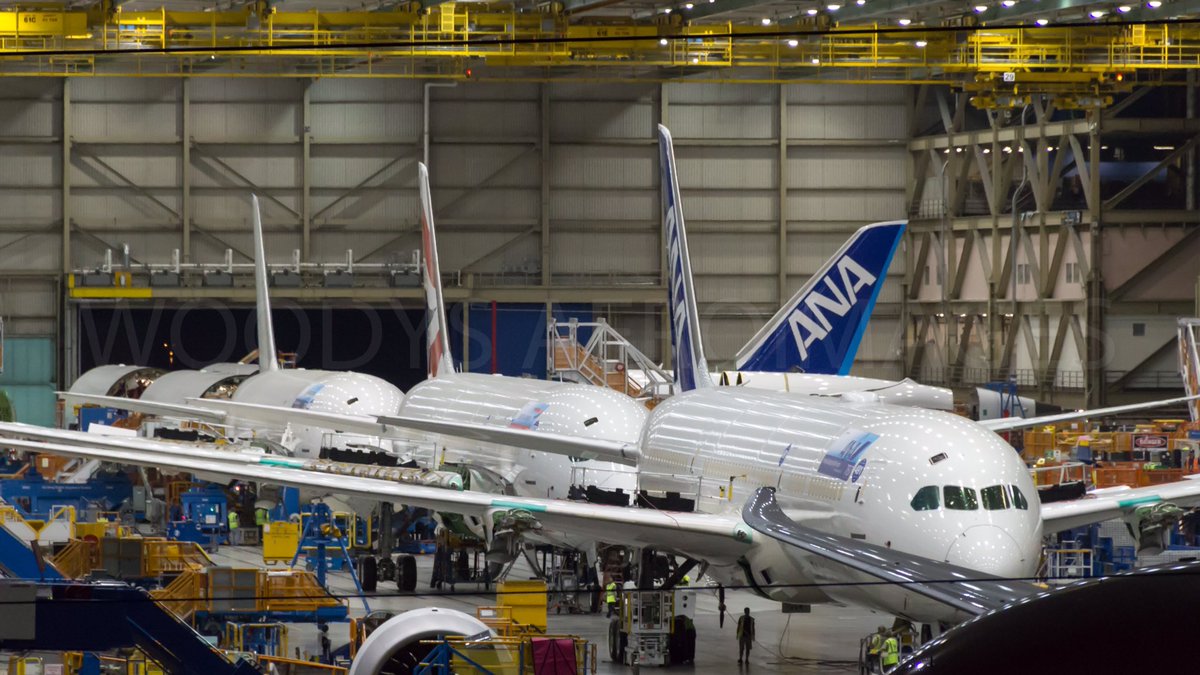A "Book to Build" (BB)
ratio has relative importance for a programs health. Ideally a ratio of one
means for every 787 ordered one is built. A solid number for a mature program.
However, successive time periods of one to one or any other ratio may indicate
a potential problem or becomes a problem for someone else.
If the backlog is small then a
manufacturer would want a slightly larger than one BB ratio until it reaches its ultimate production capability for satisfying customers.
If the BB ratio goes under 1 then the backlog may reduce itself over time where the less than 1(<1) BB then becomes a program weakness.
Because of extended <1 ratios, its production must decrease, and it will indicate a smaller cash flow going forward. If the backlog becomes so large it discourages ordering, strains supply chains and requires capital investments for plant expansion, then it becomes a management problem. Therefore a +1, 1 or <1 BB ratio becomes somebodies problem over time.
Because of extended <1 ratios, its production must decrease, and it will indicate a smaller cash flow going forward. If the backlog becomes so large it discourages ordering, strains supply chains and requires capital investments for plant expansion, then it becomes a management problem. Therefore a +1, 1 or <1 BB ratio becomes somebodies problem over time.
Currently during 2016. the Boeing BB ratio for the 787 is running at
about .45 and is <1. A manageable number because of its huge backlog that is already causing customers to wait
up to 7 years before receiving its 787's ordered. The delivery wait time becomes another relative
number depending on a customer’s needs, capitol, or market impulse. Now at this time there are
two or three driving factors affecting BB ratios were a number in itself like
.45 is a nebulous, relative, and conditional factor, dependent on multiple seasonal
adjustments throwing the whole mess into statistical ball for College graduates living in a cube.
Going back to the Boeing 2016 BB ratio for the 787, the Boeing VP
wants senior management to say the BB is right inline with our projections. which in itself, is a nebulous comment because a projection could be a bad or
good indicator of things to come.
Currently, and in Boeing's case, they are in a strong position until the backlog drops below a three year output (of about a 390 backlog) and is in a weak position when the backlog is seven years out (of about a 910 backlog). The Boeing BB can absorb about another two years of a less than "one" BB ratios before big orders are needed during a future production year.
Airbus is rolling dangerously near problems with its single aisle large backlog creating a low market order absorption capability and its leaner order intake for the A350 program will shrink its backlog at an alarming rate. The Airbus ratios fall close to a perfect storm from lack of wide body orders and too many single aisle orders adjusting its production capacity during the next five years while costing Airbus Euros. Qatar seized a moment for the 60 LOI Max orders because they too are watching ratios and backlog size , and when it needs to order for optimal deals.
Currently, and in Boeing's case, they are in a strong position until the backlog drops below a three year output (of about a 390 backlog) and is in a weak position when the backlog is seven years out (of about a 910 backlog). The Boeing BB can absorb about another two years of a less than "one" BB ratios before big orders are needed during a future production year.
Airbus is rolling dangerously near problems with its single aisle large backlog creating a low market order absorption capability and its leaner order intake for the A350 program will shrink its backlog at an alarming rate. The Airbus ratios fall close to a perfect storm from lack of wide body orders and too many single aisle orders adjusting its production capacity during the next five years while costing Airbus Euros. Qatar seized a moment for the 60 LOI Max orders because they too are watching ratios and backlog size , and when it needs to order for optimal deals.
·
The recent Qatar order for 30 787-9's is a prime clue for what the
market absorption for the 787 has become.
·
The 787 is validated from a strong Qatar (options to order)
occurrence who is the most fussy Boeing Customer.
·
In spite of other factors concerning trade deals with US military
equipment, it is a strong signal Qatar is still leveraging ordering deals and
favoring Boeing with this order. The lesson learned is that Qatar continuous
its independence with the mega builders by playing hard to get.
·
Finally, Boeing can now move forward with greater assurance moving
its BB ratio closer to 1 as an optimal position while backlog continues to
shrink.
SEE... book to build ratios are not complex, if you are a VP and have
minions to explain it all, and how it will affect Qatar at the next Middle East
Air Show. The bottom line is so much easier than BB ratios.







